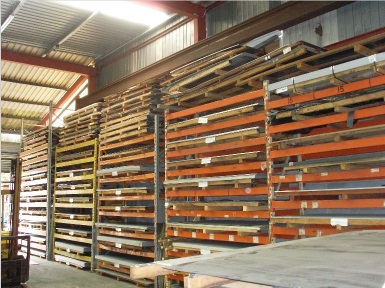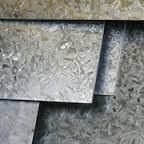
Zincanneal is forming steel modified by a post galvanizing heat treatment which converts the coating into a zinc/iron alloy. This process gives Zincanneal its smooth grey surface with a complete absence of spangle appearance. The coating which possesses good adherence to the steel base, provides a corrosion-resistant surface produced for painting directly with high quality finishes without any additional surface treatment such as priming except for severe external conditions where etch priming is recommended for optimum performance. Zincanneal steel must be painted for external applications.
Zincanneal is excellent for bending, welding and painting and is the most commonly specified steel used in the manufacture of pressed metal door frames.
Zincanneal Approximate Weight Table
Galvabond steel is a general purpose zinc-coated flat sheet. Galvabond is suitable for a broad range of applications demanding a high standard of formability, coating adhesion and resistance to corrosion.
The coating with its characteristic spangled pattern (“spangle” is defined as a glittering surface), has excellent adherence and permits a wide range of forming operations without peeling or flaking.
Galvabond is excellent for bending, welding and for painted surfaces (with pre treatment).
Glavabond Steel Approximate Weight Table
Stainless Steel is an alloy containing iron, relatively low carbon, a minimum 11% chromium and up to 30% nickel. Stainless steel is used primarily where there is a higher requirement for resistance to tea staining and for aesthetic appeal.
Stainless steel is sometimes called corrosion-resisting steel since the term stainless may suggest non-staining. It does not mean non staining in all environments, but less staining or more resistant to corrosive attack when compared with steels containing under 11% chromium.
The stock stainless steel we carry is No4 finish, a Brushed finish, and 2B, a milled finish. The mill finish is an ideal material which can be etch primed and then painted giving you the durability of stainless steel and a finish to match with your specific colour scheme.
Stainless Steel Approximate Weight Table

Care and Cleaning
Although stainless steel keeps its lustrous finish even under adverse conditions, it still needs regular cleaning. Soap and water is usually all you need but you can use a soft bristle brush if necessary. Make sure you clean in one direction along the original polish lines, not across them. Rinse well with clean water and wipe dry.
Do not use steel wool or metallic scrapers to remove non-washable deposits, do not allow dirt to accumulate or to dry out and harden and do not use cleaners containing harsh abrasives or high bleach contents.
Coated Steel
Coated steels are made up of two main components, the base steel layer and the coating layer. When working with coated steels, the process of welding and grinding can affect the coating layer of the steel. To maintain the coated surface and protect the steel from premature degradation we apply a spot prime coating over the worked areas. This process is optional but recommended as it assists in maintaining the integrity of the coating and the protection of the base steel.
Painting of Steel
The painting of zinc-coated steel sheet for either decoration or added protection may be easily and effectively carried out, providing certain basic requirements are observed. Ordinary techniques combined with readily available appropriate paints should be used, but care must be taken in the choice of paint to ensure its suitability for application in the field.
Painting in the field requires air drying paints.
Selection of paint for field use should take into account severity of the environment in which the paint will be exposed eg, rural, coastal, and industrial or other special conditions.
For satisfactory priming, the surface to be painted must be clean and dry. Dirt should be removed by washing with water, greasy deposits should be wiped with paint thinners and any loose corrosion product removed by wire brushing.
Weathering, formerly considered to improve long term paint adhesion, has since been found to give inconsistent results and is no longer recommended. One exception to this is for water-based acrylic-type paint where two weeks weathering makes painting easier by improving the wet ability of the surface. The choice of paint depends principally on the environmental conditions to be withstood.
Care should be taken in following the paint manufactures’ mixing and application instructions closely. The mixing of different brands of priming and finishing coats should be avoided.
A minimum of two finishing coats in addition to the priming coat is advised except for zinc-dust/zinc-oxide paints where a total of two is sufficient. Spray painting can be used to cover large areas at lower cost providing the paint is suitable for this method of application.
At all times it is important to avoid excessive paint build.
Pre-treatment of Galvabond with a phosphate coating system is usually employed in factory applications prior to painting.
Pre-treatment is particularly important if the products are to be used outdoors and for many interior applications where the product is exposed to humid conditions or the risk of mechanical damage.
Where pre-treatment facilities are not available, two pack etch primers may be used.
A wide variety of basic paint types is available for factory finishing, but it is important that the most appropriate paint for the particular application is selected. Usually this involves consultation with a reputable supplier in the field and it is advisable that the suppliers’ recommendations and directions for the paint systems be incorporated into an integrated process and paint technique.


